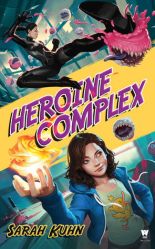Goodreads is one of my favorite resources for helping readers precisely because everything on the site is driven by actual readers and, most importantly, their opinions.
As I make very clear in my
10 Basic Rules of RA Service, one of the very best uses of Goodreads for us, the library workers, is the customer reviews-- specifically the 5 star people who LOVE the book and the 2 Star reviewers who didn’t like it and very often share their reasons why. You can get more appeal information about how and why a book did or did not work from these reviews than you can anywhere else. Even talking to a reader isn’t as useful.
My second favorite thing on Goodreads was something that is now gone, the “Others who enjoyed this book also enjoyed....” carousel. Again, the reason this worked so well as we tried to understand the appeal of a title and help readers is that this list was based on the actual readers and what else they liked. Unlike resources like NoveList, where professionals (myself included) try to intellectually match books for specific reasons, this carousel was purely based on the opinions of readers. And as we know from serving patrons and from just looking at ourselves, we often like things for reasons that don’t make measurable sense.
With that carousel gone, it was as if we lost our connection directly into the messy brains of readers. The data of people’s likes and dislikes that make sense to each individual but are harder to recreate with logic, is now lost. Or is it?
I have spent some time exploring Goodreads to recapture this more intuitive and emotionally driven type of readalike suggestion engine and I think I have found that by doing more targeted work, you will actually get even better results for your readers than you did with the carousel.
Let me explain by using a title that has a lot of appeal points--
I Am Providence by Nick Mamatas.
Click here for my review. This is a book that is a Lovecraft parody aimed at uber fans, newbies, and anyone in between. It is also a mystery, a horror novel, and fan fiction about a Con. There are many people who have enjoyed this book but they have also come at heir opinion from different angles. And that’s why using Goodreads to find someone a similar title is your best bet.
But how to narrow down what a specific reader liked about
I Am Providence and then find similar titles?
 |
Screen shot from
right gutter of entry. |
First thing I would do with someone who liked this book is to go immediately to the list of shelves Goodreads users have filed this book on. You can see a screen shot of where to access this info on the left.
Click here to see them all 387 of them. These shelves are basically what a given user wanted to remember about the book. More often than not they are frame or appeal terms. You can read these “shelf” titles to a patron and see what piques their interest.
For example some readers have shelved this as “mystery-thriller,” “Lovecraft,” even “NPR” [lots of patrons only read books they hear about on NPR; I helped a few of those over the years]. But my personal favorite was “Random Horror Stories.” As a reader, this spoke to me about this book and my experience reading it. It is horror, yes, but hard to file in a standard horror subgenre. I like it, a lot, but it was random.
So let’s pretend I am the patron here looking for a similar read. You show me the shelves to try to get the RA Conversation going [and note, you can do this without having read the book, so you can do this with any patron for any book because the “appeal” terms are on the screen] and “
Random Horror Stories” catches my eye. Even though only 1 reader of
I Am Providence used this shelf term,
the link lead you to a huge lists of titles including books by Paul Tremblay and Stephen Graham Jones, who I will tell you from experience, would totally work as readalikes for this book for me as a reader. And right at the top of the list is a book on my current to-read list--
Frankenstein in Baghdad by Ahmed Saadawi-- further proof that this works. A book I have been meaning to read shows up immediately on the screen. Done. That’s what I am reading next.
You just helped me find my next good read by using resources to show me how to help myself! Success.
What I love about doing this is that you have to have a conversation with the patron in tandem with the resource in order for this to work. Together you can find a suggestion and it doesn’t matter if you, the library worker, have read the book or not. You can use the reviews [5 star and 2 star] to find out a bit more about any title in question, straight from someone who read it and liked or disliked it, to help them as they pick their next read.
This is RA Service at it’s finest. At first I was mad at Goodreads for eliminating the carousel. But, now I would like to say “thank you.” You made me work a little harder, but in the end I have a much better way to help my patrons. Not only will it achieve more targeted and individualized results, but it will also help to develop the RA relationship by encouraging conversation between myself and the patron.


 Labyrinth Lost
Labyrinth Lost
 The Wrath and the Dawn
The Wrath and the Dawn

